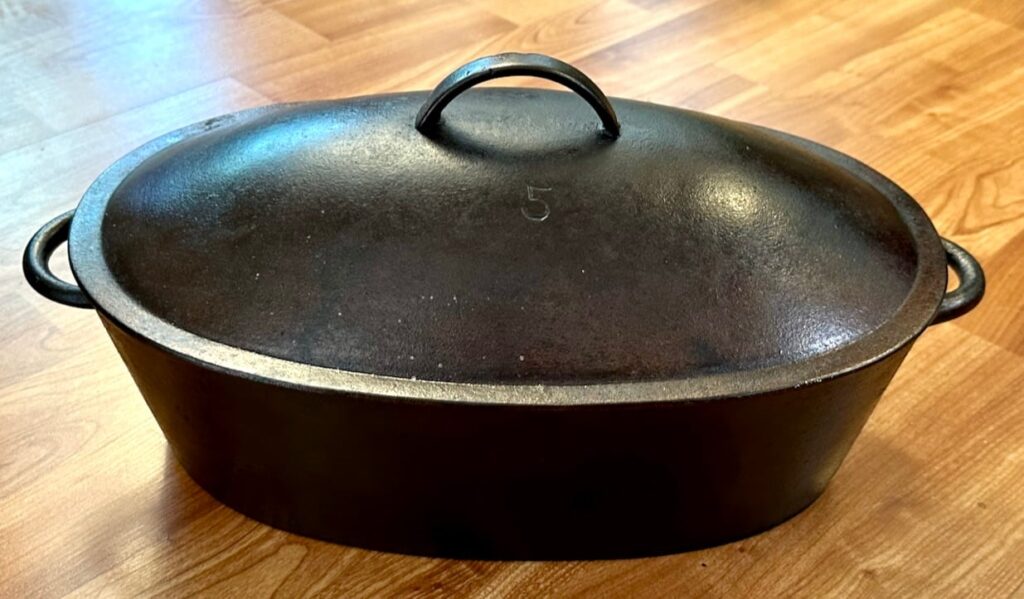Family heirlooms
again are the topic of readers’ questions about their collectibles. Uncommon and interesting table lamps, including an early Coleman kerosene example from an eastern Oregon ranch and a Rookwood “elephant” pattern of the type used at the Cincinnati Zoo, are shared. Additional keepsakes, all descended through families, include an early Wagner cast-iron covered roaster, a fine-quality Meissen plate and an ornate Gorham sterling silver bonbon spoon.
This lamp is a Model 118 “Instant Lite” kerosene lamp made by the Coleman Lamp & Stove Company of Wichita, Kansas.
Courtesy of the collector
Coleman ‘Instant Lite’ lamp
My grandparents lived on a ranch in the Keating Valley of eastern Oregon, and as a little girl, I spent a lot of time there. In the upstairs bedroom where I slept was this kerosene lamp, the shade I found fascinating. In my 20s (which would have been about 1970 or so), I asked my grandmother if I could have it. She agreed with the stipulation that I NEVER, EVER (her emphasis) light it. It was made in America, featuring a beautiful pheasant motif on the shade. The lamp stands 19 inches, and the shade is 12 inches across. Can you provide any information about it? L.A., Portland
Your lamp is a Model 118 “Instant Lite” kerosene lamp made by the Coleman Lamp & Stove Company of Wichita, Kansas. This model with a “slant generator” was made circa 1928-1930. The generator of a kerosene lamp is what helps turn liquid kerosene into a vapor for burning. The brown and gold crackled paint finish of the base appears to be the original finish. The custard-colored glass shade with pheasant decoration is a Kremelite Model 444 shade from the same period as the lamp and is likely made of uranium glass, so it will likely have a green glow if you look at it with UV (ultraviolet) light. At auction, you might expect to see an estimate of $150-$250 for this type of lamp. A dealer specializing in vintage lamps might ask $300-$400, possibly even a bit more, for a lamp of this model in excellent, all-original condition.
This “elephant” pattern table lamp was made by the Rookwood Pottery of Cincinnati, Ohio.
Courtesy of the collector
Rookwood ‘Elephant’ table lamp
I received this lamp from my grandfather, who was very active at the Cincinnati Zoo in the 1920s-30s. I was told that lamps of this pattern were used in the ladies’ restroom of the Cincinnati Zoo at that time, and he was eventually able to obtain one of them, or at least one of the same pattern. It is 27 inches tall, including the shade. I’ve never seen another one, and I would love to know anything you can tell me about it. G.L., Portland
Your “elephant” pattern table lamp was made by the Rookwood Pottery of Cincinnati, Ohio, which was founded in 1880 and was in business until 1967 (later revived in 2004). They were known for their quality art pottery. Your lamp base is of glazed ceramic and is fitted with a copper base that appears to be original. Based on your photographs of the markings on the base, the roman numerals “XIX” date your lamp to 1919, and the impressed “2491” is the pattern number of the base. The shade appears to be more recent. Rookwood pottery is collectible, and your lamp is very uncommon. Based on past auction sales, you might expect an estimate at auction of $800-$1,200 for a lamp of this type. A dealer in fine American art pottery might well ask $1,500-$2,500, if not more, for such an uncommon and collectible lamp if in excellent, undamaged condition.
This cast-iron covered roaster was made by the Wagner Manufacturing Company of Sidney, Ohio.
Courtesy of the collector
Wagner cast-iron covered roaster
My family used to own a restaurant back in the early 1900s. This was handed down to me, and I wonder if it was used when they had the restaurant? It is marked “WAGNER” and “5” on the bottom, is 16½ inches long, and about 8 inches tall. Can you tell me anything about how old it is and what it might be worth? C.L., Sandy
Your cast-iron covered roaster was made by the Wagner Manufacturing Company of Sidney, Ohio. This company was founded in 1891 by the brothers Milton and Bernard Wagner, and based on the markings in your photographs, yours is an early example, dating from circa 1891 to perhaps 1915. These were made in graduated sizes from 1 to 9, and the “5” on your roaster is the size. Wagner cast iron is popular among collectors, and earlier roasters like yours are uncommon. At auction, you see an estimate of $300-$400. Dealers in antique cast iron might ask $450-$600 for such a piece in excellent, undamaged condition.
This plate was made by the Meissen Porcelain Factory in Meissen, Germany.
Courtesy of the collector
Meissen porcelain plate
This plate came from my grandparents. We have never used it; it sits in the china cabinet. It is in perfect condition. I would be interested to know if it’s worth anything, and how old it is. It is 9¾ inches in diameter. H.D., Gresham
Your plate was made by the Meissen Porcelain Factory in Meissen, Germany. Meissen was renowned for its exceptional quality porcelain and remains active today as the Staatliche Porzellan-Manufaktur Meissen GmbH in Meissen, Saxony, Germany. Your plate is of white porcelain, and the maple leaves design is decorated under glaze with cobalt blue and gold. This pattern was very popular and was produced from circa 1860 to 1920. Based on your photographs, yours likely dates to the last quarter of the 19th century. At auction, you might expect an estimate of perhaps $50-$70 for a plate of this type. Dealers in quality antique porcelain might ask $175-$225 for such a plate in excellent, undamaged condition.
This silver bonbon spoon likely dates to the last quarter of the 19th century.
Courtesy of the collector
Gorham sterling silver bonbon spoon
This piece of sterling silver is from my grandparents or great-grandparents. It was included with the silver set, but I’m not really sure what it’s for. It is marked “sterling” and “589.” Can you tell me what it is and provide any information about it? It is 5¼ inches in length. M.B., Fairview
Your silver bonbon spoon was made by the Gorham Manufacturing Company of Providence, Rhode Island. They were founded in 1865 and are still active today. Based on the markings in your photographs, your spoon likely dates to the last quarter of the 19th century. The design possibly depicts putti serving either the goddess Venus or Aphrodite. Your spoon is also monogrammed “K,” which commonly would represent the first letter of the last name of the owner. This may help you identify where it originated within your family. At auction, you might expect to see an estimate of $100-$150 for a spoon of this pattern. Dealers in American antique silver currently ask $200-$250 for this pattern of spoon in excellent condition.
Stories by
Jerry Dobesh
-
This century-old crazy quilt is a family heirloom. What is it worth?
-
These silver serving pieces are family heirlooms. What were they for, and what are they worth?
-
This camera captures a moment in photography’s history. What is it worth?
-
Family silver, a German doll and soldiers’ World War I mementos: What are they worth?
-
Century-old wicker furniture is a family heirloom. What is it worth?
Today’s Collectibles
The values discussed for items featured in this column were researched by Portland appraiser
Jerry L. Dobesh
, ASA, an Accredited Senior Appraiser with the American Society of Appraisers, with a specialty designation in Antiques & Decorative Arts. His services include providing appraisals for estate tax, charitable contribution, insurance scheduling and loss, and equitable distribution needs.
To find an appraiser, contact the
American Society of Appraisers
, the
International Society of Appraisers
, or the
Appraisers Association of America
. Estimates suggested in this Collectibles column are for general information purposes only and cannot be used as a basis for sale, insurance, or IRS purposes.
To have items considered for inclusion in future columns, please send us your high-quality images, preferably at least 300 dpi, 1Mb in size and in jpeg format. Photos must show each object in its entirety and must be clearly focused and well lighted to show detail. If there are any maker’s marks, please include an image of those. Include measurements and information about the condition of the piece.
Send to:
jerry@dobeshappraisal.com
or mail to:
Today’s Collectibles/Homes & Gardens The Oregonian 1500 SW First Ave., Suite 500 Portland, OR 97201
Please include your name and town, along with contact information; phone number or email address. Contact information will not be published. The Oregonian will retain usage rights of the photographs





More Stories
This cast-iron roaster was used in a family restaurant a century ago. What is it worth?
This cast-iron roaster was used in a family restaurant a century ago. What is it worth?
This cast-iron roaster was used in a family restaurant a century ago. What is it worth?